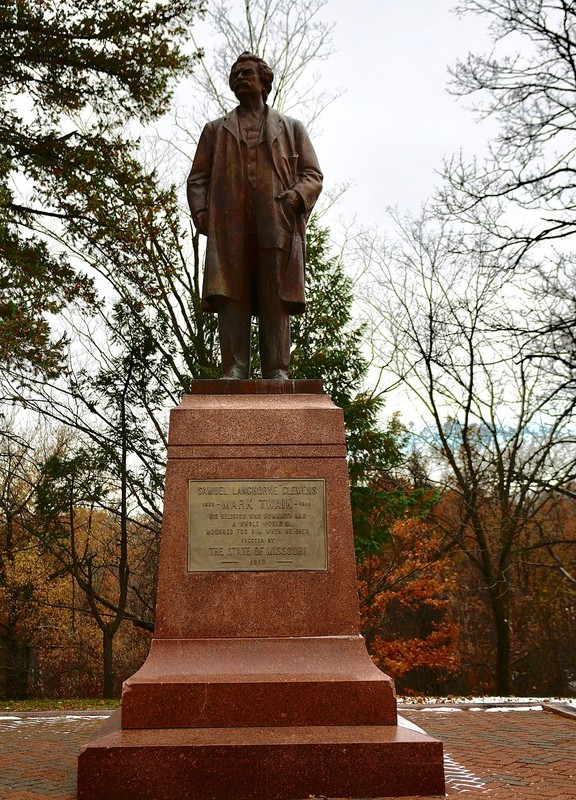Riverview Park and the Mark Twain Statue
Introduction
Text-to-speech Audio
Although waterside parks in our nation's towns and cities are ubiquitous in the twenty-first century, and the park's Mark Twain statue is its most famous feature, Riverview Park also exists as part of the widespread conservation movement that emerged around the turn of the twentieth century, helped in part by such principal figures as John Muir, Frederick Jackson Turner, and Teddy Roosevelt. Entrepreneur, philanthropist, and conservationist Wilson B. Pettibone funded and created the park in 1909, hiring an acclaimed Progressive Era and Prairie Style landscaper from Chicago, O. C. Simonds, to complete the project. The park's original intent was to showcase and preserve the local prairie environment without adding artificial features such as picnic tables, playgrounds, or ball fields. While the main philosophy remains, the 465-acre park today does include a few artificial features, including restrooms, trails, and playgrounds.
Images
This statue of Mark Twain, Hannibal native and one of the country's greatest writers, was installed in 1913.

Looking over the Mississippi River from Riverview Park

Autumn in Riverview Park

Backstory and Context
Text-to-speech Audio
Riverview Park spans more than 450 acres along the Mississippi River. Wilson B. Pettibone, a wealthy lumber magnate and philanthropist, contributed substantially to the park as part of his passion for conservation. In 1908, Pettibone developed his idea for a park that would follow the principles of the Prairie Style landscape philosophy, emphasizing the naturalness of the land.
Well before the late nineteenth-century conservation movement grew popular, and ideas about naturalistic landscape design came into vogue. As early as 1941, a periodical entitled The Horticulturalist included an article about rustic landscaping consisting of curvilinear footpaths, airy meadows, and captivating vistas. While most of the progressive landscaping principles involved celebrating the local setting, the naturalistic idea also involved transplanting local trees and shrubs from nearby (still local) locations. A century later, the Riverview Park landscaping included the transplanting of multiple local wild trees and shrubs.
Riverview Park exemplifies the evolution of landscaping ideas from the 1840s through the turn of the twentieth century, as American landscapers adapted ideas garnered from English gardening and transformed them into the American Prairie gardening style. Generally, the Prairie Style drew inspiration from the native Midwestern environment comprising landforms, waterways, flora, and fauna. Embedded within the Prairie Style landscaping philosophy was the conservation movement, which gained momentum after the Civil War as Americans worried about their "closed frontier" and the depletion of natural resources, so Prairie Style landscapers also sought to preserve characteristic "Western" scenery.
Pettibone's vision for Riverview Park coincided with the Progressive Era, the conservation movement, and the growing popularity of Prairie Style landscaping. In addition to the development of parks nationwide, Theodore Roosevelt established numerous National Parks and wildlife areas. Still, Missouri did not have an official state park until the 1920s. Most parks arose similarly to Riverview Park through private funding such as Pettibone's philanthropy. However, Pettibone differed from other philanthropists who spearheaded parks in other Missouri cities as he embraced the naturalistic ideal. At the same time, they routinely built standard parks such as zoos, picnic grounds, playgrounds, and artificially landscaped parks with fountains.
Pettibone legally protected his vision for Riverview Park, allowing a governing board composed of nine Hannibal residents to control it only if they adhered to his original intent; otherwise, the park would revert to the Pettibone family. Pettibone's first requirement stated that the park should "forever be free from all political, religious, social or other bias, without prejudice, preference, or discrimination." Pettibone demanded that the park be free of any artificial construction (including fountains or picnic tables), allowing the park to be a showcase for the area's natural beauty. Part of the beauty included a view of the Mississippi River, made possible by Pettibone's numerous land purchases along the river to develop the park, eventually spanning 465 acres.
By May 1909, Pettibone hired lauded landscape architect O. C. Simonds of Chicago to design the park. Simonds' work in Chicago personified Progressive Era ideals and conservation movement landscaping, working with conservationists to preserve undeveloped rural land near Chicago. After completing the initial work on the park in 1909, Simonds developed the park's scenic overlook and the layout for the location of the Mark Twain sculpture. One year later, in 1913, the Mark Twain statue (designed by Frederick Hibbard, who later sculpted the Tom & Huck statue in downtown Hannibal) found its place at the park's highest point along with a viewing platform.
Sources
Adams, Ansel. "The Closing of the American Wilderness." Public Broadcasting System (PBS) American Experience. Accessed August 1, 2024. https://www.pbs.org/wgbh/americanexperience/features/ansel-closing-american-wilderness/.
Baxter, Karen Bode, Matthew Cerny, and Mandy K. Ford. "Registration Form: Riverview Park." National Register of Historic Places. mostateparks.com. 2005. https://mostateparks.com/sites/mostateparks/files/Riverview%20Park.pdf.
Jacoby, Karl. Crimes Against Nature: Squatters, Poachers, Thieves, and the Hidden History of American Conservation. Berkeley: University of California Press, 2001.
Kingsland, Sharon E. The Evolution of American Ecology: 1890 - 2000. Baltimore: The Johns Hopkins University Press, 2005.
Library of Congress. "Conservation in the Progressive Era." loc.gov. Accessed August 1, 2024. https://www.loc.gov/classroom-materials/united-states-history-primary-source-timeline/progressive-era-to-new-era-1900-1929/conservation-in-progressive-era/.
"Riverview Park." Hannibal Parks & Recreation Department. Accessed August 2, 2024. https://www.hannibalparks.org/parks/riverview-park.
Steinberg, Ted. Down to Earth: Nature's Role in American History. New York: Oxford University Press, 2009.
Turner, Frederick Jackson. "The Significance of the Frontier in American History, 1893. A paper read at the meeting of the American Historical Association in Chicago, 12 July 1893, during the World Columbian Exposition. Excerpts." National Humanities Center. Accessed July 31, 2024. https://nationalhumanitiescenter.org/pds/gilded/empire/text1/turner.pdf.
By Jim Roberts - Own work, CC BY-SA 4.0, https://commons.wikimedia.org/w/index.php?curid=74426129
https://visithannibal.com/explore/riverview-park/
https://www.hannibalparks.org/parks/riverview-park/
